#National Museum of Montenegro
Explore tagged Tumblr posts
Text
Cetinje
The former capital until 1946, Cetinje was one of my favourite places in Montenegro. It was compact, and filled with lovely buildings and interesting museums. The old town centre is pedestrianised, and there isn’t much traffic anywhere else. A day there was the perfect amount of time to see literally everything. The best views of Cetinje are from Eagle Rock, which felt harder to climb that it…

View On WordPress
#Billiard Palace#Blue Palace#British Embassy#Castle Church#Cetinje City Hall#Djukanovic Palace#Eagle Rock#Ethnographic Museum of Montenegro#French Embassy#King Nicholas Museum#Ministry of Culture#Monastery of St Paul#Money Museum#Montenegro#National Museum of Montenegro#photography#Relief of Montenegro#Russian Embassy#travel#Vlaška Church
0 notes
Text
Rating food of the countries I've been to, from West to East:
Disclaimer: it's veeery subjective
***
Spain🇪🇸 : 7/10. It's okay. I expected their fish and seafood to be better, tho. A LOT of relatively cheap fresh juices, 10/10 for health. They also make surprisingly amazing pasta and surprisingly average paella.
France🇫🇷: 9/10. Never visited cafes or restaurants there, but Carrefour has an incredible variety of good meat. I love their pineapple pie, too. There are a lot of products for vegetarians, Muslims, and, in general, different people who have different eating styles. There's a lot to see. And omg, their bazaar days are something worth attending: I still regret that I never tried clams with white wine.
UK🇬🇧 : 6/10. Not impressed. Something tells me that they deliberately make fish-n-chips that terrible. But I absolutely loved the strawberries under hot chocolate, which was sold by two cheerful Polish girls near Madam Tussaud museum.
Switzerland 🇨🇭: 6/10. Migros has nice buns with spinach and those Japanese "sandwiches", overall, your whole salary is gonna be spent on food. (Lithuania core lol😭) McDonald's there SUCKS.
Norway🇳🇴: 4/10. I expected a lot for some reason. Prices gonna cause you a heart attack, the quality is gonna give you a second heart attack. Also!!! THERE WAS NO FISH IN THE SHOPS EXCEPT THE CANNED!!! I was deeply injured. Norwegian salmon is super popular in Ukraine, how can they not have any normal fish in the big supermarkets...
Germany🇩🇪: 1/10. I may be just unlucky, but every time I visit Germany and pick a random cafe with lots of people(!), it has the worst food I've ever tasted in my life. It's like that scene from Desperate Housewives: "Really? A woman who orders Chinese food for Christmas dinner cooked a pineapple pie?" I understand now why Ukrainian women often marry Germans. My heart bleeds when I see what exactly you eat. I want to cover you with a blanket and cook you a normal soup.
Czech Republic 🇨🇿: 7/10. The soup was nice, ставлю вподобайку👍
Poland🇵🇱 : 8/10. Soup in bread, my beloved. Doughnuts were some kind of overcooked in oil, tho.
Montenegro🇲🇪: 10/10. I love you. I love your salads, your seafood, and I LOVE YOUR LEMON ICECREAM!!!!!
Slovakia🇸🇰: 7/10. I don't really remember what I ate, I am sorry. But I was really impressed with your supermarkets for some reason. Gotta visit it again.
Hungary🇭🇺: 6/10. It was my first time I've ever tried street food, and I liked it. You guys know how to cook meat.
Greece🇬🇷: 7/10. One day, I'll find the guy who can cook Karavidopsiha and beg them to cook it once again. Nice fish!!! I remember your arbutus honey as old women remember their best lovers. But. One time, a man served my family with unpeeled shrimps in batter. :/ What the hell was that? Is that some kind of a national dish I'm not aware of? Minus three points for such bullying.
Cyprus 🇨🇾: 7/10. I shouldn't be obsessed with your carob tree pastille that much.
Lithuania🇱🇹: 10/10. I love you. Although, I'd love to spend less money on food too. I love your Maxima and Rimi and Iki. I love your cafes. I love your bakery, I love your cocktails, I looooooove your soups, and I love your Asian food too. It's very easy to become an alcoholic with such delicious wines and tinctures.
Latvia🇱🇻: 11/10. Oh my god. Oh my god. I'm on my knees. Your cream chanterelle soup and Lidl croissants and marinated onion and šašlyk and fish and dairy products🛐🛐🛐. You guys know how to serve. I've never seen such pretty food designs anywhere. And of course, Lido. It brings me in tears of joy and makes me remember Puzata Hata. No, for real, is there any dish you don't know how to cook?
Finland🇫🇮: 7/10. That's okay. Nice street food.
Belarus ⚪️���⚪️: 9/10. Oh my dear Belarus, you're gonna be the best chef in Europe once you're free from russia. I wish I ate more machanka and drank your pine tincture when I had the chance. I love your chicory, it's a bit greyish, but it's much more delicious than an average chicory. Delicious meat in the shops. Other food is soviet-like, which makes me nauseous.
Ukraine 🇺🇦: ♾️/10. Вітчизно моя! Ти як здоров'я, наскільки ти цінна, тільки той знає, хто тебе втратив. I don't know if my favourite shops still work. I loved every single cafe I've been to, yes, even that shitty prorussian Mafia and Eurasia. I loved Puzata Hata. I loved Khlibna Kava, and its amazing cherry cupcakes. I loved Moloko Vid Fermera. I loved little kiosks with fresh Makadamia nuts and huge variety of vegetables and fruits. I loved Flagman and Silpo, Lvivśki croissants, and chocolate shops. I loved my seafood store. I loved giant frappes in Shevchenko Park. I loved my Continent with its old classical French background songs. I love my Japanese food stores. There are so many places I love. I used to find my bazaar so ugly and dirty, but I would give everything to buy the sea buckthorn jam from the cheerful old lady. But it's not gonna happen. My bazaar was shelled by russians to the ground.
Turkey🇹🇷: 9/10. Your Katmer, seafood soup and baked shrimps(?) are something 🛐.
Jordan🇯🇴: 7/10. Nice! You cook paella better than Spain, be proud of yourself. Although, I'd love to not be scared for my life as a woman all the time. Your bazaar seemed very interesting, but unfortunately, I don't speak Arabic. And I am a woman, which also sucks, I guess. I was totally covered in black, except for the face and hair, and people still stared at me like on a zoo exponate. McDonald's kinda sucks too, but not as much as in Switzerland.
Egypt🇪🇬: 7/10. It's okay. I've tasted only hotel food.
Sakartvelo🇬🇪 : 10/10. Our guide forgot about our existence, and we had to find any source of food to not die from hunger, so we went to your local bazaar and asked to fry some cheap fish. It had lots of bones, and I hate fish with bones, but I ate it all, and it tasted amazing.
Saudi Arabia 🇸🇦: 6/10. Most of the week, I just cooked some simple spiceless products like pasta and eggs from the small store. You are far from the level of grocery stores in Turkey. Although, your cold orange juice bottle saved my life from dying in the middle of the desert.
Qazaqstan 🇰🇿: 7/10. I don't really remember your supermarkets, I guess they were okay. But your bazaars are definitely something worth attending. Millions of varieties of honey with millions of tastes and very salty hard cheese Kurt.
15 notes
·
View notes
Text
What Are the Top 10 Europe Trip Packages from Mumbai for 2025?
If you’re dreaming of a European getaway in 2025, you’re not alone. Europe offers a rich tapestry of history, culture, and natural beauty, and with Europe Trip Packages from Mumbai in 2025, planning your adventure has never been easier. TravelMaddy, one of the top travel agents in Thane, curates tailor-made Europe Tour Packages From Mumbai to suit every traveler’s preferences. Here are the top 10 Europe trip packages to consider for 2025:
1. Greece Packages from Mumbai
Discover the breathtaking beauty of Greece with visits to Athens, Santorini, and Mykonos. Explore ancient ruins, enjoy stunning sunsets, and indulge in authentic Greek cuisine. This package is perfect for history buffs and beach lovers alike.
2. Spain Tour Packages from Mumbai
Immerse yourself in the vibrant culture of Spain. From the artistic streets of Barcelona to the royal palaces of Madrid and the sunny beaches of Costa del Sol, this tour offers an unforgettable mix of history, art, and relaxation.
3. Romantic Paris Escape
Paris, the City of Love, is a must-visit for couples and art enthusiasts. With iconic landmarks like the Eiffel Tower, Louvre Museum, and Seine River cruises, this package ensures a magical experience.
4. Swiss Alps Adventure
Explore the pristine beauty of Switzerland with this package. Visit Zurich, Lucerne, and Interlaken, and take scenic train rides through the majestic Swiss Alps. Don’t miss the Jungfraujoch, known as the “Top of Europe.”
5. Italy Classic Tour
Step back in time with this package that covers Rome, Venice, and Florence. Marvel at ancient ruins like the Colosseum, stroll through romantic canals, and admire Renaissance art in Florence.
6. Best of Eastern Europe
Explore the charming cities of Prague, Budapest, and Vienna. From gothic architecture to relaxing thermal baths and musical heritage, this package is a cultural delight.
7. Scenic Scandinavia Tour
Experience the beauty of Northern Europe with visits to Norway, Sweden, and Denmark. From fjords and northern lights to Viking history and modern cities, Scandinavia offers a unique experience.
8. The Enchanting Balkans
Visit Croatia, Montenegro, and Slovenia with this offbeat package. Discover stunning coastlines, medieval towns, and lush national parks.
9. Ultimate UK and Ireland
This package covers the iconic landmarks of London, Edinburgh, and Dublin. Explore castles, countryside landscapes, and historic cities filled with charm.
10. Comprehensive Europe Tour
Can’t decide on a single destination? Opt for this all-in-one package that includes highlights from France, Switzerland, Italy, and Germany. Perfect for first-time Europe travelers.
Why Choose TravelMaddy for Europe Packages From Mumbai?
TravelMaddy, located in Thane, specializes in creating hassle-free Europe Tour Packages From Mumbai. Here’s what sets us apart:
Customized Itineraries: Tailored to suit your preferences.
Affordable Options: From luxury to budget-friendly packages.
Expert Guidance: Our team ensures a smooth travel experience.
Specialized Services: Whether you need Greece Packages from Mumbai or Spain Tour Packages from Mumbai, we’ve got you covered.
Final Thoughts
2025 is the perfect year to explore Europe with TravelMaddy. With our carefully curated Europe Trip Packages from Mumbai in 2025, you’re guaranteed a memorable experience. Whether it’s the beaches of Greece, the art of Spain, or the mountains of Switzerland, Europe has something for everyone. Book your dream vacation today and embark on a journey of a lifetime.
Related Keywords
Europe Trip Packages from Mumbai in 2025 | Europe Tour Packages From Mumbai | Europe Packages From Mumbai | Greece Packages from Mumbai | Spain Tour Packages from Mumbai | Travel Agents in Thane
0 notes
Text
Discovering the Balkans: A Journey Through Southeast Europe

Southeast Europe, often referred to as the Balkans, is a region rich in history, culture, and breathtaking landscapes. For Bangladeshi travelers, exploring the Balkans offers a unique opportunity to delve into diverse traditions, picturesque towns, and stunning natural beauty. This journey will take you through some of the most captivating destinations in the Balkans, revealing the charm and complexity of this fascinating region.
The Journey Begins: From Dhaka to Belgrade
Your Balkan adventure starts with a flight from Dhaka to Belgrade, the vibrant capital of Serbia. With convenient layovers in major international hubs like Istanbul or Dubai, reaching Belgrade is straightforward. Upon arrival, you'll be welcomed by the city's dynamic blend of old-world charm and modern energy. Stroll through the historic Belgrade Fortress, offering panoramic views of the confluence of the Danube and Sava rivers. Explore the lively Knez Mihailova Street, lined with shops, cafes, and historic buildings. Don't miss the bohemian quarter of Skadarlija, where you can enjoy traditional Serbian cuisine and live music.
Sarajevo: The Heart of Bosnia and Herzegovina
Next, head to Sarajevo, a city known for its rich history and multicultural heritage. The drive from Belgrade to Sarajevo takes you through picturesque landscapes and quaint villages. In Sarajevo, visit the historic Baščaršija bazaar, where you can wander through narrow streets filled with shops selling traditional crafts and souvenirs. The Gazi Husrev-beg Mosque and the Latin Bridge, site of the assassination that sparked World War I, are must-see landmarks. Experience the city's unique blend of East and West, reflected in its architecture and cuisine. Try local dishes such as cevapi and burek, and enjoy a traditional Bosnian coffee.
Montenegro: The Jewel of the Adriatic
From Sarajevo, travel to Montenegro, a country renowned for its stunning Adriatic coastline and rugged mountains. Start your exploration in Kotor, a UNESCO World Heritage site known for its well-preserved medieval architecture and scenic bay. Climb the ancient city walls for panoramic views of the bay and surrounding mountains. Continue to Budva, famous for its beautiful beaches and vibrant nightlife. The historic old town, with its narrow streets and Venetian-style buildings, is a delight to explore. Don't miss the opportunity to visit the Lovćen National Park, where you can hike to the mausoleum of Montenegro's beloved hero, Njegoš, and enjoy spectacular views.
Albania: The Land of Eagles
Next, venture into Albania, a country with a rich history and diverse landscapes. Start in Tirana, the capital city, where you can explore Skanderbeg Square, the heart of the city, and visit the National History Museum to learn about Albania's past. The colorful buildings and vibrant street art add a unique charm to the city. From Tirana, travel to Berat, known as the "City of a Thousand Windows" for its distinctive Ottoman-era architecture. The Berat Castle, perched on a hilltop, offers stunning views of the surrounding area. Enjoy Albanian hospitality and traditional dishes such as byrek and tave kosi.
North Macedonia: A Land of Contrasts
Continue your journey to North Macedonia, where ancient history and modern culture coexist harmoniously. In Skopje, the capital city, visit the impressive Alexander the Great statue and the Old Bazaar, one of the largest and most well-preserved in the Balkans. The Stone Bridge, a symbol of the city, connects the old and new parts of Skopje. Travel to Ohrid, a UNESCO World Heritage site known for its beautiful lake and historic churches. The Church of St. John at Kaneo, perched on a cliff overlooking Lake Ohrid, is particularly picturesque. Enjoy local Macedonian cuisine, including dishes like tavče gravče and ajvar.
The Return Journey
As your journey through the Balkans comes to an end, reflect on the diverse cultures, histories, and landscapes you’ve experienced. Each destination offers its own unique charm, making the Balkans a region full of surprises and unforgettable moments.
Conclusion
Discovering the Balkans provides Bangladeshi travelers with an enriching adventure through Southeast Europe. From the vibrant streets of Belgrade to the serene beauty of Lake Ohrid, this journey showcases the region's rich heritage and stunning landscapes.
Plan Your Balkan Adventure with Roomchai Limited
Roomchai Limited specializes in crafting personalized travel packages for Bangladeshi travelers. With expert guidance, seamless logistics, and exceptional service, Roomchai Limited ensures a smooth and enjoyable journey through the Balkans. Let Roomchai Limited handle the details while you explore the wonders of Southeast Europe, creating unforgettable memories along the way.
0 notes
Text
United Nations heritage body UNESCO announced on Thursday evening that six ex-Yugoslav republics agreed to renovate Block 17 of the Auschwitz-Birkenau Memorial and Museum, a former shared exhibition space which has stood empty for many years because the six countries could not agree how the events of the Holocaust in Yugoslavia should be represented.
The deal was made after 14 years of negotiations and UNESCO director-general Audrey Azoulay said that it “fills a void, an absence of memory at the very site where these horrors unfolded”.
“It shows our joint commitment to learning from the past and healing the wounds of history, which transcends borders and generations,” Azoulay said at a ceremony at UNESCO headquarters in Paris to announce the agreement, according to a press release.
Around 20,000 people from Nazi-occupied Yugoslavia were sent to Auschwitz-Birkenau concentration camp, most of them Jews, but also Roma.
In the mid-1960s, a Yugoslav national exhibition was opened in Block 17 of the Auschwitz-Birkenau State Museum in Oswiecim. The exhibition was last updated at the end of 1980s, just before the violent break-up of Yugoslavia.
During and after Yugoslavia’s collapse, memorialisation of World War II events became a contentious issue between its successor republics, who often interpreted history differently for contemporary political purposes. This meant there was no further cooperation over the Auschwitz exhibition and the Yugoslav pavilion was eventually closed in 2009.
The Serbian Ministry of Culture said in a statement on Thursday that the agreement “envisages the joint financing of the renovation and conservation of the first floor of Block 17 and the common rooms and structures that the former Yugoslav republics share with Austria”.
The agreement also envisages “the joint financing of the costs of implementing a joint permanent exhibition at the place of remembrance for the victims from the territory of the former Yugoslavia in the concentration camp and Auschwitz-Birkenau extermination camp”.
Montenegrin Culture Minister Tamara Vujovic said that “through this agreement, Montenegro and other former Yugoslav republics are showing solidarity and commitment to preserving the memories that connect us”, Radio Television Montenegro reported.
The director-general of the Auschwitz-Birkenau Foundation, Wojciech Soczewica, said after the signing that it was “a clear sign” that the governments of the six ex-Yugoslav states “are willing … to contribute to memory and our responsibility towards future generations”.
The announcement of the agreement came ahead of International Holocaust Remembrance Day, when ceremonies are being held in countries across the region to commemorate the victims.
On Friday in Zagreb, a Croatian parliament delegation led by speaker Gordan Jandrokovic laid a wreath at the monument to Moses at the Mirogoj cemetery, while deputy prime minister Davor Bozinovic did the same on behalf of the government.
“This is also a moment to remember what the Jewish people contributed to Croatian society,” said Zvonimir Troskot from the MOST (Bridge) party, who was part of the parliamentary delegation.
A wreath was also laid on behalf of the Social Democratic Party, SDP, whose president, Pedja Grbin, said the Holocaust was a crime that “must never happen again”.
“Unfortunately, today we see the hatred that is flourishing in Europe and the world. Again, people are attacked because they are different,” Grbin warned.
“If you look around the world, the number of people who deny that the Holocaust even happened is frightening,” he added.
Traditional Jewish visitation stones were also placed at the monument in memory of the Holocaust’s victims by the president of the Jewish Municipality of Zagreb, Ognjen Kraus, and Rabbi Luciano Moshe Prelevic.
In the Bosnian capital on Friday, the Jewish Community of Bosnia and Herzegovina and the Jewish Municipality of Sarajevo also organised a commemorative event to honour Holocaust victims.
Jakob Finci, president of the Jewish Community, noted that six million Jews perished in the Holocaust, but some survived.
“Today, despite the passing years, we have nearly 245,000 people who survived the Holocaust. Of them, 54 live in our country. Therefore we should, not only for them who are alive but for ourselves, remember it and speak about it to others,” Finci said.
In Montenegro, parliament and the Jewish Community will hold a commemoration on Saturday.
1 note
·
View note
Text
The top 7 indoor activities to do in Montenegro
Step into the warmth of Montenegro's interior wonders, as the nation offers a treasure trove of experiences behind four walls, rain or shine. Montenegro, located in the heart of the Balkans, welcomes you to explore its rich texture through a range of indoor activities. Explore the ancient halls of Montenegro's museums for echoes of the past. Whether it's the National Museum of Montenegro in Cetinje or the Maritime Museum in Kotor, each indoor area reveals cultural and historical stories, providing a safe sanctuary for discovery. Those who enjoy tastes may immerse themselves in Montenegro's culinary mysteries by taking cookery workshops. Learn to make traditional delicacies like "evapi" and "pasulj" at home, where cooking becomes a pleasant excursion into the heart of the culture.
Looking for a break from the outer world? Montenegro's health centers provide indoor sanctuaries set against magnificent scenery. Allow the inside to become a refuge for relaxation and regeneration by indulging in spa treatments and yoga sessions. In Montenegro, rainy days will not dampen your spirits. Whether you're interested in history, gastronomy, or health, the country's interior activities provide a warm welcome, enticing you to discover its hidden treasures no matter what the weather outside is like.
Here are some indoor activities to do in Montenegro.
1. Visit Montenegro's museums to learn about the country's rich history: Montenegro has a remarkable past, and its museums take you on a trip through time. Begin your indoor trip with the Montenegrin National Museum in Cetinje. You may find relics, paintings, and exhibitions that highlight the country's cultural legacy here. Another hidden treasure is the marine museum in Kotor, which provides insights into Montenegro's marine history. Immerse yourself in historical stories while being safe from the weather.
2 Culinary Treats in Cooking Classes: Escape the inclement weather by enrolling in a cooking class to learn the art of Montenegrin cuisine. Local cooks will teach you how to make traditional delicacies like "evapi" (grilled minced pork) and "pasulj" (bean soup). You will not only enjoy a great dinner at the end, but you will also gain vital culinary skills. It's a terrific opportunity to interact with Montenegro's culture through its cuisine, all while relaxing in the comfort of your own kitchen.
3. Relaxation and Wellness Retreats: Indoor activities do not have to be solely exploratory; they may also be rejuvenating. Montenegro has wellness resorts set against stunning scenery. Relax with spa treatments, yoga lessons, and meditation classes. These getaways, whether in the highlands or along the Adriatic coast, offer a wonderful respite from the hustle and bustle, enabling you to rest and refresh.
4. Daring Indoor Climbing: Consider indoor climbing facilities dispersed around Montenegro if you want to have fun without having to brave the elements. In a safe and regulated setting, put your climbing talents to the test. These facilities accommodate all ability levels, whether you're a beginner or an expert climber. It's a terrific way to keep active, push yourself, and have a thrilling indoor experience.
5. Appreciation of Art in Galleries: Montenegro's dynamic art culture is on display at the country's various galleries. Spend a day in Podgorica or Kotor viewing modern and traditional artworks. For art lovers, the Miodrag Dado Uri Art Gallery in Cetinje and the Modern Gallery in Podgorica are must-see destinations. Immerse yourself in the different manifestations of Montenegro's creative community while being safe from inclement weather.
6. Workshops and Classes for Education: Indoor activities may be cognitively interesting as well. Participate in educational courses and classes to stimulate your intellect. Montenegro frequently organizes workshops on a variety of topics, ranging from language classes to craft creation. Look for opportunities to learn something new at local events and community centers. It's a fantastic opportunity to meet new people, learn new skills, and make your indoor experience both enriching and entertaining.
7. Adventures in Escape Rooms: Try an escape room experience in Montenegro for a pinch of thrill and collaboration. These interactive games require players to solve puzzles and riddles within a specific time constraint. It's an excellent indoor pastime for families, groups of friends, or even lone travellers. Engage your problem-solving talents and enjoy an immersive experience that blends excitement and entertainment, all while being protected from outside weather disturbances.
As your indoor journey in Montenegro comes to an end, the experiences you made within these safe havens will live on as priceless treasures. Whether you immersed yourself in the rich history housed in museums, learned the skill of Montenegrin cuisine in cooking lessons, or sought refuge and renewal in health resorts, each encounter reveals a different element of this Balkan jewel. Indoor activities in Montenegro provide not only a retreat from the unpredictable weather but also a canvas of various interactions that vibrate with warmth and cultural depth.
The attractiveness of indoor activities is a tribute to the country's hospitality for tourists contemplating Montenegro for their next vacation, particularly from Dubai. Montenegro holiday packages from Dubai now include not just the charm of breathtaking vistas but also a wealth of indoor wonders just waiting to be discovered. Montenegro's allure extends beyond its external vistas, encouraging visitors to discover its stories, tastes, and peacefulness within the warmth of its inner settings, rain or shine. Carry the warmth of Montenegro's culture, the depth of its history, and the promise of future experiences beneath its sheltering domes with you as you wave farewell to its interior havens.
0 notes
Text
Kroatië, Bosnië-Herzegovina & Montenegro
9 september - 20 september
🇭🇷 Vanaf onze laatste stop in Slovenië rijden we de grens over en komen na een half uurtje in Zagreb aan. Hier wandelen we door deze (voor ons totaal nieuwe) stad die toch weer heel anders is dan Ljubljana. Ietsjes rauwer maar ook wel weer erg authentiek. We lopen door gezellige straatjes met cafeetjes en restaurants en doorkruisen pleinen en uitzichtpunten, we zien namelijk niet alleen het lagere maar ook het hogere gedeelte van deze stad. Verder zien we ook veel toeristen en voelen we enige noodzaak om ook op tijd weer bij onze achtergelaten Franky te zijn, een onderbuikgevoel.

🏕️ Gelukkig is Franky nog altijd vast en veilig en brengt hij ons verder Kroatië in, in de richting van de Plitvice meren. Maar vanwege de belachelijke prijzen voor zowel toegang in dit park als de prijzen aan de kust voor campings of camper-plaatsen en de strenge controle op wildkamperen met gigantische boetes als gevolg, brengen we een kleine verandering aan in onze plannen. Wij gaan niet via de kust van Kroatië omlaag, maar steken de grens over met Bosnië-Herzegovina. Hier kunnen we weer ouderwets wildkamperen en zien we direct veel moois.
🕌 De natuur is weer rijkelijk aanwezig, net zoals het deel van Kroatië waar we vandaan kwamen, maar in tegenstelling tot Kroatië zien we hier al direct moskeeën en minaretten opdoemen aan de horizon. We rijden als eerst naar de stad Bihać. Hier scoren we een sim kaartje en wat contant geld in de lokale munteenheid (nu we buiten de EU zijn, wel zo handig) en maken voor het eerst kennis met het Bosnische straatbeeld. Een beetje verwarrend nog. Soms netjes en zelfs idyllisch, soms rommelig en verpaupert.
Wij overnachten in Una National Park, recht aan de helderblauwe rivier, genaamd Una. Het is hier muisstil (zijn helemaal alleen), heerlijk groen en we spotten al snel een uil in de boom aan de overkant van de rivier en zien we meerdere ijsvogels druk in de weer. Genieten! In dit park leven ook lynxen, beren en wolven, maar die zien we niet.

🏞️ Wat we wel doen is op deze plek een enorm verfrissende duik nemen: wat geen overbodige luxe is met deze warme dagen van rond de 30 graden. Verfrissend is het zeker, ijskoud zelfs. En wij dachten dat we na zwemmen in zoveel rivieren, meren, zeeën en oceanen deze reis wel wat gewend waren geraakt. Gelukkig komt er die avond nog een Nederlands stel genaamd Jorik en Carina in hun camperbusje bij. We noemen even hun namen, want die zijn het onthouden waard voor later in deze blog. Die avond komt er ook nog laat een Duitse jongeman aan. Deze laatste staat er de volgende ochtend op om gezamenlijk een duik te nemen. Wij slaan over aangezien we ‘t al hebben beleefd en het echt niet normaal koud was. Ach deze mensen kennen het allemaal. Gezwommen in de koudste rivieren in Slovenië en blabla. Ze kunnen ons maar moeilijk geloven en met z’n drieën gaan ze voor onze neus erin. En eruit. Direct eruit. Koudste wat ze hebben meegemaakt! 7 graden is de conclusie, best koud toch?

💦 Na Una National Park rijden we door naar de stad Jajce, waar de Pliva watervallen dwars door de stad stromen en waar zelfs vanaf gedoken wordt door de echte pro’s. Helaas niet in ons bijzijn, wat extra jammer is omdat de stad zelf verder een klein beetje tegenvalt.
🧨 We rijden dan ook snel weer door naar de hoofdstad Sarajevo. De wegen in dit land vallen ons alles mee, niet veel snelweg maar toch prima wegdek. En door het platteland, door dorpjes en stadjes. We zien enorm veel en dit land is echt geweldig mooi. Aan de rand van Sarajevo vinden we een hele fijne en vooral veilige camperplek voor een zachte prijs. Hier ontmoeten we opnieuw een leuk Nederlands stel genaamd Sam en Jalien uit Zeeland, met wie we die dag al even bij het dichtbij zijnde Tunnel of Hope museum kijken. Dit is de tunnel die in de oorlogsjaren ‘92-‘95 gebruikt werd om wapens, voedsel, medicijnen etc naar de belegerde stad te smokkelen. Erg indrukwekkend om te zien, met de sporen en gaten van kogels en mortiergranaten in het huis en rondom op de grond.
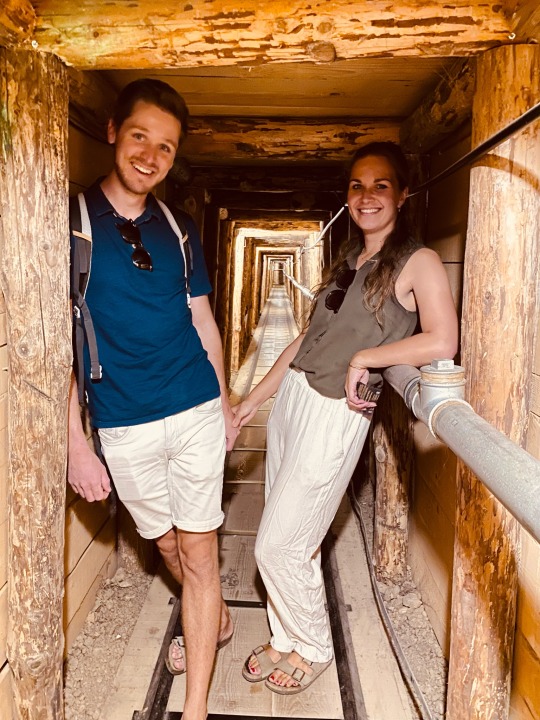
🚃 De volgende dag stappen we samen met onze Zeeuwse reisgenoten een oude bus in en vervolgens een nog ouder trammetje in, op weg naar de stad. Deze verrast ons eigenlijk enorm. Aan de ene kant zien we continu sporen van de oorlog van de jaren ‘90. We zien opvallend veel gebouwen met kogelgaten nog in de muren (trouwens ook veel gezien buiten de stad), maar er zijn ook veel mooie gebouwen, bruggen en gezellige straatjes met ook de nodige toeristen.
We eten een lekker Bosnisch hapje en nemen de stad in ons op, wandelen heerlijk wat rond. We zijn verbaasd over de Ottomaanse invloeden hier en het voelt bijna een beetje alsof we in de medina’s van de Marokkaanse steden rondlopen: Veel smalle straatjes met winkeltjes vol met allerlei handgemaakt spul, terwijl de ambachtsmannen hun volgende creatie aan het polijsten zijn. We zien een mooie moskee, lopen langs een net zo grote synagoge en passeren een aantal mooie kathedralen, het gaat hier allemaal samen. Klein Jeruzalem wordt deze stad om die reden ook wel genoemd.
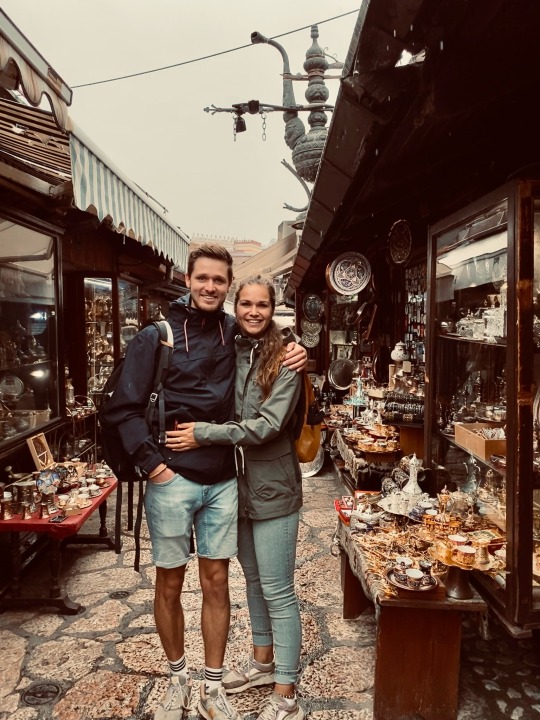
🚐 Na deze dag rijden we alvast halverwege Mostar, de volgende stop.
We vinden op Park4night een plek bij een local, waar we niets hoeven te betalen maar wel wat kunnen consumeren en op die manier een bijdrage kunnen leveren.
Het laatste stuk is langs een rivier op een smal weggetje door twee hoge bergkammen. Tegemoetkomend verkeer is ons enige obstakel, vooral als we een kleine stoet leidend opeens een dikke BMW tegenkomen maar eigenlijk geen kant op kunnen. Gelukkig is achter de BMW een ruime verbreding van de weg maar mevrouw achter het stuur voelt zich even te goed om achteruit te rijden voor ons en de rest van de stoet. Helaas is er geen andere oplossing en na veel boze handgebaren en onnodig alternatieve oplossingen zoeken, besluit mevrouw dan toch maar de achteruit te proberen. We zien dan ook gelijk waarom dit voor haar geen oplossing was. Waarschijnlijk de eerste keer dat ze ‘m in de achteruit gebruikt. Maar met veel hulp en nog meer onvrede lukt het dan toch en kunnen we door! Dit was trouwens geen local, om jullie absoluut niet een verkeerd beeld te geven van de lokale bevolking hier!

🐟 We komen aan bij Anis en zijn vader Nijaz. Ze hebben hun stuk land aan de rivier omgetoverd tot een soort picknick-plek 2.0. Je kan hier zelfs houtje touwtje douchen en gebruik maken van een ‘toilet’ (lees: gat in de grond 👍🏻), maar bovenal heerlijk vertoeven met zitjes langs de rivier en zelfs op de rivier gebouwd.
Ze hebben hier zelfs een forellenvijvertje aangelegd waar we zelf onze forellen uit mogen vissen. Daarna maakt Anis ze heel vakkundig en rap gereed voor op de barbecue. Even later zitten we aan de heerlijke verse visjes met een biertje uit de ‘Bosnian fridge’. Kratje in de rivier zeg maar. Het is eenvoudig maar ook rijkelijk. De gastvrijheid van deze mensen is aandoenlijk en sowieso merken we dat de bevolking erg warm en uitnodigend reageert, waar we ook zijn. Hier is het land nog niet overspoelt met campers en toeristen, wat natuurlijk ook helpt. Toch zien we meer toeristen en buitenlandse nummerborden dan we hadden verwacht.
🏰 Na deze tussenstop rijden we alweer een prachtige route door bergen en langs meren en rivieren, richting Mostar.
Deze stad blijkt verrassend toeristisch maar is ook wel erg kneuterig en gezellig. Wij parkeren op veilige afstand van de binnenstad, zodat we er op onze stalen rossen gemakkelijk en snel naartoe kunnen. Vanuit Mostar is het maar een kort ritje van zo’n 20 minuten naar Blagaj waar een prachtig 16de eeuws moslim-klooster is gebouwd bij de ingang van een rots aan de bron van de rivier, niet genaamd Una, maar in dit geval de Buna. Echt een plaatje!
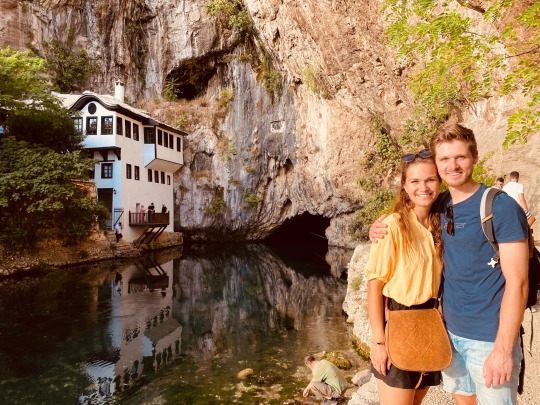
We sluiten de dag af in de buurt van de Kravica watervallen, op een rustig plekje in de natuur.

🪵 We nemen hier de volgende dag weer een heerlijke duik in de helderblauwe rivier en bouwen gezellig kampvuur waar we ons eten op maken. Na het vele reizen in korte tijd is dit het moment voor een rustdagje.
🏖️ Maar rust is er niet voor lang! We vertrekken namelijk de volgende ochtend rond 07:30 zodat we rond 08:00 bij de Kravica watervallen zijn, voor de hordes toeristen aan, die vanuit andere delen van Bosnië-Herzegovina of zelfs vanuit Kroatië aankomen. Het werkt: wij zijn er bijna de enigen, met nog een lekkere ochtendkoelte en de rust van de natuur. Al is het wel meteen een doorn in het oog hoe het toerisme hier het beeld bepaalt. Aan de voet van de waterval, waar je trouwens in het water kan en mag zwemmen, is ook het volgebouwd met ligbedjes en eettentjes. Verder is het wel een mooie plek, maar zo’n € 10,-/20 Bosnische Mark p.p. vonden wij het misschien toch niet waard. Maar ons Bosnische geld is hiermee wel op, maar gelukkig kunnen we her en der toch gewoon met euro’s betalen, dus we gokken het erop.
⛰️ We rijden direct erna door naar het zuidoosten van het land, het Sutjeska National Park met daarin de laatste grote oerbossen van Europa!
Het is alleen wel een behoorlijk lange rit over wegen waar je praktisch niet harder dan 60 mag of kan. Na een tijdje wordt het wegdek dan ook erg slecht en beginnen we behoorlijk te klimmen. Het valt ons op dat de wegen in het Noorden van het land wat beter waren (of we hadden gewoon geluk), en het rijgedrag van onze mede verkeersdeelnemers daar ook iets relaxter was. Hier zit er wat meer ongeduld en temperament in en wordt er af en toe agressief heen en weer gewuifd naar ons. Dat we sneller moeten, dat we aan de kant moeten en dat soort ellende.
Het is dan ook een lange dag rijden in de Bosnische hitte en na een paar mooie tussenstops in dit prachtige gebied, besluiten we samen met Sam en Jalien, om een camping aan de grens met Montenegro te bezoeken zodat we hier ook nog wat wasjes kunnen draaien. Tenzij we een beter (gratis) plekje in de natuur vinden.

💨 Net voor we bij de camping aankomen, pauzeren we even kort om een laatste overleg te plegen. We vinden onderweg geen leuke plekjes dus het wordt toch die camping. Met dat de knoop is doorgehakt begint er opeens, net als bij belangrijke keuzes in het Vaticaan, witte rook uit ons dashboard(kastje) te komen. We zetten snel de motor uit en proberen te kijken of er iets gevaarlijks aan de hand is, en dan komt er opeens als een engeltje uit een doosje een ander Nederlands camperbusje langs zeilen. Jorik en Carina dus! Die precies hetzelfde gammele bergweggetje aan het uitproberen zijn. Laat Jorik nou net een handige Harry zijn, vooral met elektronica die zelf ook met een oud Fiat Ducato camperbusje op pad is en die hij helemaal door en door kent van al het klussen aan dat ding. Hij doet direct wat checks terwijl we gestoord worden door vriendelijke Bosniërs die ons even laten weten dat ze Nederland kennen, en dat hij overmorgen in Hengelo en Emmen zal zijn (hoe dan?!). De file die deze smalltalk veroorzaakt deert de man weinig, maar hij rijdt uiteindelijk vol enthousiasme en al lachend weer door. Wij besluiten ook dat er geen acuut gevaar is en we rustig met z’n zessen die laatste paar kilometer kunnen afleggen in de hoop dat het goed gaat. En dat gaat het gelukkig. De colonne met de drie Nederlandse fiatjes komt aan bij de… tja ‘camping’.
🔩🔧 Dit blijkt niet helemaal de standaard camping te zijn die we misschien in gedachten hadden, maar we kunnen er prima staan, betalen in euro’s en inclusief die € 15,- per nacht elektriciteit aansluiten en oneindig veel wasjes draaien.
Vooral om dat laatste besluiten we om dan maar 2 nachten te blijven zodat we die gehele dag kunnen benutten met wasjes draaien en vooral met Jorik inzetten om eens de elektra in en rondom onze motor te checken. Dit doet hij met alle liefde en geduld en passie en hij checkt van alles en nog wat. Hij stuit daarbij op totaal ongerelateerde eigenaardigheden maar kan al met al wel uitsluiten dat er echt iets ‘mis’ zou zijn. Geen gevaar maar nog wel een klein raadsel wat dit veroorzaakt heeft. Een kwestie van goed in de gaten houden dus. Jorik en Carina vertrekken die middag wel alvast maar Sam en Jalien gaan met ons de volgende ochtend vroeg weer door.

🏞️ We steken de grens met Montenegro over en komen direct in een fantastisch prachtig gebied. We zijn helemaal versteld van dit prachtige landschap en ook verrassend goede wegen. We scoren snel een sim kaart, 500 gb voor een tientje haha. Normaal lopen we te hannesen voor sim kaartjes met 30, 60, 80 of eens een 100 gb aan data, maar in dit land doen ze niet zo moeilijk. En we betalen hier ook weer in euro’s, ideaal!
🇲🇪 Daarna vervolgen we de route door het prachtige Durmitor National Park. We wanen ons het ene moment weer in de Franse Alpen, het andere moment in Lord of the Rings/The Hobbit-achtige landschappen, maar zijn toch echt gewoon in Europa, in de Dinarische Alpen. Het is hier wonderschoon en we eindigen de route net voorbij Zabljak.
📍 Het plan voor nu (altijd onderhevig aan veranderingen en geniale ingevingen) is om door het binnenland van Montenegro verder te rijden, en de kust te bewaren voor later. We gaan dan de grens over met Kosovo en via Noord-Macedonië naar Albanië, waarna we via de kust van dit land en die van Montenegro en Kroatië weer terug ‘omhoog’ zullen gaan.
De groeten uit de Balkan!
0 notes
Text
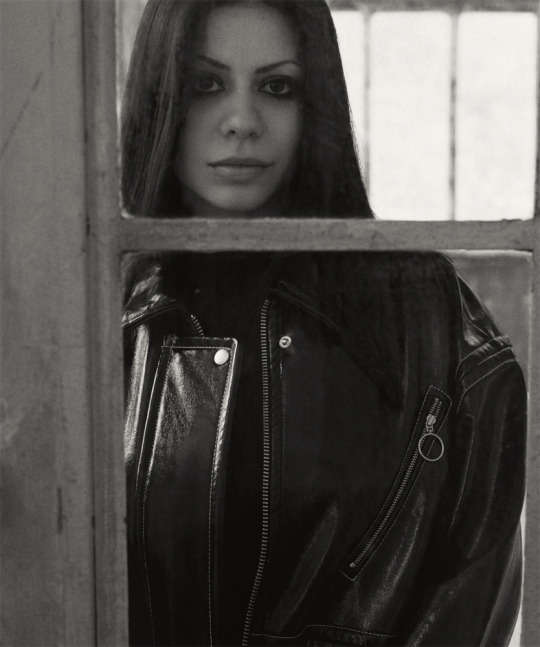
Darja Bajagić (b. 1990 in Podgorica, MNE) lives and works in Chicago and Bogišći, Montenegro. She received her MFA from Yale University in 2014, and her BFA from Pacific Northwest College of Art in 2012. Selected solo and two-person exhibitions include: Forest Passage, Downs & Ross, New York, US (2022); Crucio, November Gallery, Belgrade, RS (2022); Goregeous, Le Confort Moderne, Poitiers, FR (2020); Transfiguration, New Galerie, Paris, FR; Born Losers, Hessel Museum of Art, Annandale-On-Hudson, US (2018); Unlimited Hate, Künstlerhaus, Halle für Kunst & Medien (KM–), Graz, AU (2016). Selected group exhibitions have taken place at National Gallery Prague, CZ (2021); Futura Centre for Contemporary Art, Prague, CZ (2019); Es Baluard Museu d'Art Modern i Contemporani de Palma, ES (2018); Contemporary Art Centre (CAC), Vilnius, LT (2018); LUMA Westbau, Zürich, CH (2017, 2015, 2014); Musée d'Art moderne de la Ville de Paris, FR (2015); Moderna Museet, Stockholm, SE (2015); Museum of Modern Art in Warsaw, PO (2014); Museo de Arte Contemporáneo de Oaxaca, MX (2014); Museum of Applied Arts (MAK), Vienna, AU (2013).
Her works pull together fragments culled from a panoply of sources including pornography websites, religious iconography, murderabilia stores and sensationalized news reporting of grotesque murders. Brazenly explicit, these compositions hold a mirror to a sinister world that, despite its aspirations towards liberal advancement, is inflicted by the fetishism of cruelty and exploitation.
0 notes
Photo



#summer#holiday#travel#montenegro#lovcen#national park#museum#stairs#landscape#view#horizon#rock#mountains#deep#green#valley#clouds#blue#sky#nature#beautiful#world#hiking#adventure#exciting#challenge#canon#canon 1200d#photography#tourist
5 notes
·
View notes
Text
Virtual Visits

I know a lot of us would like be able to visit other places right now. It looks like we won’t be able to do that for a while, but we can at least pretend!
Museums:
Egyptian Museum (Floor 1, Floor 2)
Inside the Louvre (Part 1, Part 2 (also includes Napoleon Apartments))
The British Museum
Natural History Museum, Washington, DC
National Palace Museum in Taipei, Taiwan
Russia’s Hermitage Museum
National Gallery of Art, Washington, DC
Victoria & Albert Museum, London
Sherlock Holmes Museum
Natural History Museum, London
National Museum of Scotland
Libraries:
New York Public Library Tour
Guided Tour of the Library of Congress in 360°
Boston Public Library Tour
Old Library Ambience
Ambience: Being in an Old Library while it Rains
Royal Library Ambience: Rain and Fireplace
Luxurious Study Room/Library Ambience
Study in the New York Public Library
Ambience - Writer’s Library from the 1930′s
University + Study with Me:
Columbia University, Manhattan, NY
University Lunchroom Ambience
Study with a Friend at Columbia University’s Butler Library
Study with Another Friend
Korean Student Study with Me
Walking Around Yale University in New Haven, Connecticut
Oxford in the snow (some talking)
Walk a City:
NYC Museum Mile Walk
Dubai - Marina Waterfront to Jumeirah Beach
Monte-Carlo, Monaco
Amsterdam City Center
Valencia, Spain
Historic Heidelberg, Germany
Ho Chi Minh Nightlife
Hanoi Nightlife
NYC Midtown Manhattan (Part 1, Part 2)
Walking in the Rain in Tokyo
Walking in the Rain in Boston, MA
Downtown Seattle + Top Attractions
Downtown Chicago
Downtown San Francisco
London - Oxford Circus to Bloomsbury
Prague, Czech Republic
Historic Naples
Sydney + Historical Landmarks
Caythorpe Village + English Countryside
Castleton Village + English Countryside
Walk Nairobi, Kenya
Cairo Khan el-Khalili, Market (skip intro)
Lagos Town Center in the Algarve, Portugal
Grimmelwald Switzerland
St. Ives, Cornwall
Groningen, Netherlands - Martini Tower to Groninger Museum
Walk New Orleans in the Rain
Walk Paris, France
Visit Historical Landmarks:
The Eiffel Tower
Berlin TV Tower
Saigon Skydeck (Bitexco Tower), Ho Chi Minh, Vietnam
London Eye, Big Ben, Buckingham Palace
The Empire State Building
Statue of Liberty Tour
Walk of the Taj Mahal
The Colosseum, Rome
The Great Wall of China
Walk the Golden Gate Bridge
Machu Picchu (Part 1, Part 2, Part 3)
Leaning Tower of Pisa + Extra (some talking, mute if needed)
Visit the Roman Forum
Parks + Nature:
Forest Walk - Grand Ridge Trail, Issaquah, WA
Winter Forest Walk
Forest Hike - Baker River Trail & Chain Lake Trail
Forest Walk - Middle Fork Trail in Snoqualmie
Phacelia Flowers Field
Flowery Meadow, Bird Sounds Ambience
Butterflies and Flowers in a Meadow
Relaxing Meadow and Mountains
Scenic Drives:
From Nice to Monaco
English Countryside - Buxton, Blakewell, Matlock Bath
Banff National Park, Icefields Pkwy, Alberta, CA
San Francisco Pacific Coast Highway
Byway 12, Utah (with music)
Miami, FL Drive
Mount Rainier (Foggy, forested roads) (with music)
Furka Pass, Switzerland
Public Transport:
Tokyo Yurikamome Train
Tokaido-Sanyo Shinkansen Train
Sea to Mountains Train, Montenegro
NYC Subway - 96th to Times Square
Norway Subway from Stortinget to Jernbanetorget
London Bus Ride - Big Ben, Trafalgar Square, Regent Street
Scuba Dives + Snorkeling:
Music and some editing is just unavoidable in these kinds of videos for some reason? Please be ready to mute if needed.
Roatan, Honduras - Half Moon Bay Wall and Dixie’s Place
Florida Keys - Horseshoe Beach
Scuba Diving the Egypt Red Sea
Raja Ampat, West Papua, Indonesia Coral Reef
Maldives Deep South Diving
Triton Bay to Raja Ampat, Kaimana
Hawaii Oahu Scuba Diving
Scuba Diving in Molokini Crater Maui Hawaii
Cafe Ambience:
There’s a lot of these that seem the same, but trust me, they are different.
Cozy Coffee Shop with Jazz and Rain
Rainy Day at Cozy Shop with Jazz
Rainy Night at Coffee Shop with Romantic Jazz
Rainy Day Cafe with Piano Music
Zen, Relaxing Rainy Day at a Cafe
7 Hours of Actual Coffeeshop Footage (with chill music)
Restaurant Ambience:
Romantic, Cozy New York Restaurant Ambience
Restaurant with Background Music
Outdoor Italian Restaurant at Night
Misc. Public Places
Staten Island Mall
The Florida Mall
Mall of America
Dubai Airport
Oceanografic Valencia, Spain (Largest Marine Park in Europe)
Tilburgse Kermis Funfair Carnival
Magical/Other Worlds:
Cozy Medieval Cottage Home with Rain and Fireplace
Magical Potion Shoppe Ambience
Witch’s Lair Ambience
Peaceful Nature Covered Subway with lofi (and cat)
Magical Forest Ambience
Witchy Coffee Shop
A Cozy Home:
Cozy Vintage Home with Fireplace and Thunderstorm
Cozy Winter Ambience with Fireplace and Snowstorm
Cozy Cabin Ambience
Randomizers:
The Secret Door: Tour random places in Google Maps.
Geoguessr: Get “lost” on Google Maps and find where you are.
Also tag yourself I’m “Peaceful Nature Covered Subway with lofi (and cat)”
3K notes
·
View notes
Text




Portraits of Serbian women in traditional town costumes by Đura Jakšić, 19th century. cred. National Museum (Serbia), Gallery of Matica Srpska, National Museum (Montenegro).
Portrait of a woman, 1871.
Stana Ristić, 1871.
Granddaughter of knez Mileta, 1873.
Živka Protić, a teacher, 1866.
#serbia#19th century#balkan#slavic#eastern europe#gradska nošnja#paintings#serbian paintings#art#đura jakšić#bundiceeee
73 notes
·
View notes
Text

Fjord-like … Perast town in the Bay of Kotor, Montenegro. Photograph: Olga_Gavrilova/Getty Images
Wild East (Alternative Europe): Five Balkan Countries To Discover For Your Next Holiday
Done Spain, Italy and Greece? These countries offer spectacular landscapes, unspoilt swimming spots, ancient towns – and affordable prices
— Rachel Dixon | Sunday 7 August 2022
Montenegro
With the Adriatic to the south and mountain ranges in the north, Montenegro is an easy place to combine a beach break with a more active holiday. The beach scene is centred on the medieval walled city of Budva, which has a 22-mile strip of sandy and pebbly coastline. Lake Skadar, southern Europe’s biggest, is about an hour’s drive away, perfect for boating among water lilies and Dalmatian pelicans.
Fjord-like, Unesco-listed Bay of Kotor, encircled by mountains, is unmissable. There are several medieval towns, numerous churches and monasteries around its shores; from baroque Perast, sightseers can visit the islet of Our Lady of the Rocks. In Kotor town, 1,355 steps lead to the Sveti Ivan fortress, with spectacular views.
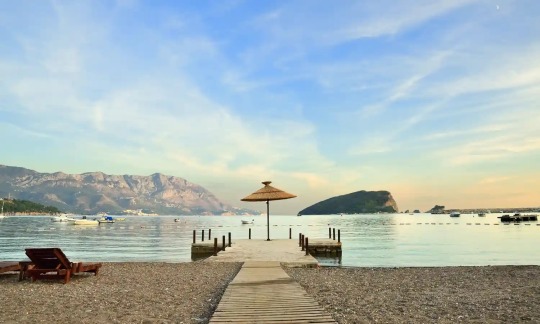
Budva. Photograph: Kuriyama Chikara/Getty Images
Heading north, sights include the mountain-top mausoleum of 19th-century ruler Petar II Petrović-Njegoš; Cetinje, the former capital; and the Ostrog Monastery, built into a cliff. Durmitor national park, with its forests, lakes and mountains, is the ultimate destination for outdoor adventure. Zabljak, highest town in the Balkans (1,456 metres), is a good base. Visitors can zipline across the 1.3km-deep Tara Canyon; go white-water rafting on the Tara river; swim in the Black Lake; or brave wolves and bears as they hike 25 marked trails.
Kosovo

Mirusha waterfalls are in a protected park in central Kosovo known for its canyons and karst landscape. Photograph: Olivier Wullen/Alamy
Kosovo declared independence from Serbia in 2008 and remains a largely undiscovered tourist destination for Britons, who perhaps still associate it with the year-long war in 1998. But today it is a safe place to travel, with few crowds and low prices. Landlocked Kosovo comprises two major plains surrounded by mountains with 50 peaks over 2,000 metres. That means great hiking, horse riding and skiing. With no sea, swimming in natural pools is popular: the Mirusha Waterfalls have canyons, caves and 13 lakes. There is a lively nightlife scene in Pristina, the capital, and in the second city Prizren. It’s partly thanks to this Balkan state having the youngest population in Europe – more than 65% of people are under 30. The two cities also have many mosques, museums and monuments, including Pristina’s Emin Gjiku ethnographic museum and the Newborn monument, unveiled for independence and painted in a different style every year.
Elsewhere, top sights include four Unesco-listed monasteries and churches – Dečani, Peć, Gračanica and Ljeviš; the Bear Sanctuary, home to European brown bears rescued from captivity by the charity Four Paws; and Gadime Cave, full of crystallised stalagmites and stalactites.
Slovenia

Ljubljana is a city of baroque and Habsburg buildings. Photograph: kasto80/Getty Images
Slovenia has a charming capital city; mountains, lakes and forests; fine wines; and even a short stretch of coastline. Ljubljana, the compact capital, is built around the river Ljubljanica, with baroque and Habsburg buildings on both banks. A glass of wine on a riverside terrace is hard to beat, but the city also has a hilltop castle, art galleries, theatres and museums (featuring Europe’s only complete mammoth skeleton at the Museum of Natural History), iconic 20th-century architecture by Slovene Jože Plečnik, and wooded Tivoli Park.
Piran is the loveliest town on the Slovenian coast, with Italianate architecture reflecting centuries of Venetian rule
In the north-west of the country, the top sights are the spectacular Lakes Bled and Bohinj in the Julian Alps. On the other side of the mountains, the less-visited Soča Valley offers hiking, rafting and kayaking in summer, and skiing and snowboarding in winter.
Heading south, must-visits include the Postojna and Škocjan caves, and Predjama Castle, built into a cave mouth. Piran is the postcard town on the coast, with Italianate architecture reflecting centuries of Venetian rule.
East Slovenia is wine country – lively Maribor, the second city, boasts the world’s oldest vine – and is a good choice for a farm stay. Ptuj, the oldest town in Slovenia, is a pretty place for a day trip.
Bosnia and Herzegovina

Hikers in the Sutjeska national park. Photograph: Witold Skrypczak/Alamy
Another country associated with 1990s warfare, Bosnia and Herzegovina is back on the backpacker trail. The capital, Sarajevo, has been likened to a miniature Istanbul or Jerusalem, with its old town, Baščaršija, full of bazaars, mosques and restaurants. But recent history hasn’t been forgotten: the Historical Museum and Tunnel Museum both tell the story of the four-year siege that killed 10,000 people in the 1990s.
Mostar, in the south, is the second-biggest draw, famed for its beautiful Old Bridge – visitors can pay to dive off it if they dare. Less touristy (and longer) is Arslanagić Bridge in the pretty town of Trebinje in the far south-west. Other notable towns include Travnik, the former Ottoman capital, and Jajce, with a spectacular waterfall.
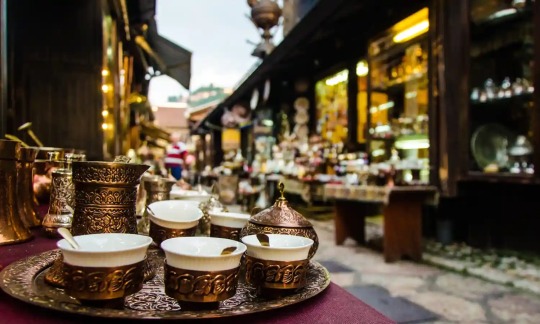
Baščaršija, Sarajevo’s old town. Photograph: Federica Gentile/Getty Images
White-water rafting is popular from March to October; one of the best rafting regions is around the town of Bihać, handy for the rapids of the Una river. Other active options include multi-day hikes in the Sutjeska national park, overnighting in mountain huts, and the 10-day TransDinarica mountain biking trail from Mostar to Sarajevo. Riders stay in B&Bs and homestays and eat homegrown food. In winter, there is affordable skiing in the Bjelašnica and Jahorina mountains south of Sarajevo.
North Macedonia

North Macedonia is blessed with lakes. Photograph: AleksandarGeorgiev/Getty Images
North Macedonia – so-called since 2019 – is a mountainous but green Balkan state. While it may be landlocked, it is blessed with lakes: most famously Ohrid, one of Europe’s oldest and deepest, but also Prespa, Dojran and more than 50 smaller glacial lakes.
Unesco-listed Lake Ohrid is the top attraction, surrounded by ancient monasteries, beach bars and seafood restaurants. Activities include lakeside cooking classes, e-biking, boat trips and paragliding. The town of the same name is full of churches and monuments, and dotted along the lake are picturesque fishing villages.
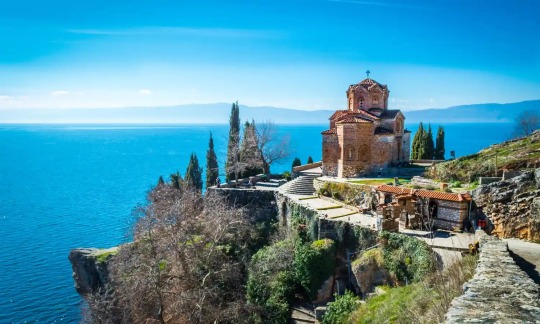
Church of St John at Kaneo, Lake Ohrid. Photograph: Saraginov/Getty Images
Skopje, the capital, is less immediately appealing, but retains a Byzantine fort and an Ottoman centre, plus modern additions such as the Museum of Contemporary Art. Mavrovo national park, on another lake and home to bears, wolves and lynx, offers hiking, biking, horse riding and swimming in the summer, and skiing in the winter. It’s also home to the picturesque, 11th-century Sveti Jovan Bigorski monastery. The other national parks are Galičica, found between lakes Ohrid and Prespa, and Pelister, a mountain with two glacial lakes.
4 notes
·
View notes
Text

Zorka Karađorđević née Princess Zorka of Montenegro, c. 1883
Artist: Š. Bocaric
Oil on canvas, 119 x 70 cm
Source: National Museum in Belgrade, obtained from confiscated paintings, 1951.
#princess zorka of montenegro#Zorka Karađorđević#Ljubica Petrović-Njegoš#montenegro#serbian royal family#1883#1880s#painting#princess zorka of serbia#Petrović-Njegoš
57 notes
·
View notes
Text
Yugoslavia Express
in a discussion with the photographer Roberto Conte, who discovered the modernism of Yugoslavia during his 9000 km photo trip.

Portrait Photo © Melania Avanzato
Roberto, why is an Italian, Western guy interested in Yugoslavia National Liberation struggle monuments from the WWII?
As an architecture photographer I work a lot with the post-war modernist architecture. I soon realized that a former neighbor nation of my country was literally disseminated by very interesting structures, rather expressionist but with a more modern appeal, with some extremely interesting solutions or design proposals with so many names that would deserved to be known more and that is the worthy purpose of many publications and exhibitions like the project organized by Architectuul. I didn't know much about Yugoslavia in general, despite the geographical proximity.

Monument to the Uprising of the People of Banija and Kordun (1971-1981) in Petrova Gora, Croatia by Berislav Šerbetić | Photo © Roberto Conte
My first trip to Belgrade was in 2015, followed by a big tour in 2017. One thing, that impressed me very much, is the locations of most of memorials and monuments strictly tied to the places were important and often painful historical events took places and not just a way to celebrate those people from the distance, like in the main cities itself. It's really a strong connection with the genius loci, the spirit of the place, and that gives a totally different read to these monuments and, of course, a totally different approach about the preservation of them.

Korčanica Memorial Complex (1975-79) by Ljubomir Denković on Grmeč mountain in Bosnia and Herzegovina | Photo © Roberto Conte
For example, just to mention two of the most famous spomeniks, I would like to mention the monuments in Petrova Gora, Croatia, and in Grmeč, Bosnia and Herzegovina. They both remember episodes of resistance dating back to WWII and located in the very places where things happened, and that gives a lot to them. The first is located on a hill and the surreal silence of the area is just broken by the low buzz of the repeaters/signal amplifiers put on the top of it. The second lies literally in the middle of the forest, in this case with the only buzz of mosquitos. As a person interested in the topics architecture, memory and time it's strange to see them.
On your trip map are also many other sites, not only monuments, how did the research started and what was the context of your research?
My very first trip was in Belgrade, were I explored the city a lot with the focus on the suburbs. I was totally surprised to see the Genex Tower as well as the whole New Belgrade, but also the Rudo Buildings, the now famous Toblerone in Karaburma and so many more. Despite the conditions of some of them, while some are in way better shape that many public housing complexes in Italy, I realized that in those years there was a genuine push in providing a real and modern home to many people that were moving to a fast growing city on a scale that I had never seen before.

Konjarnik neighborhood (1972-75), New Belgrade | Photo © Roberto Conte
On top of that, many buildings related to leisure activities, such as the 25 May Sport Complex, the Museum of Contemporary Art, the Aeronautical Museum or the Pionir Sport Complex were designed in a very innovative way and a complementary feature in this idea of modern city and modern urban citizen. After that trip I wanted to discover more, therefor I started to research and read more where I broadened my interest also to the memorials for the National liberation struggle of the WWII.
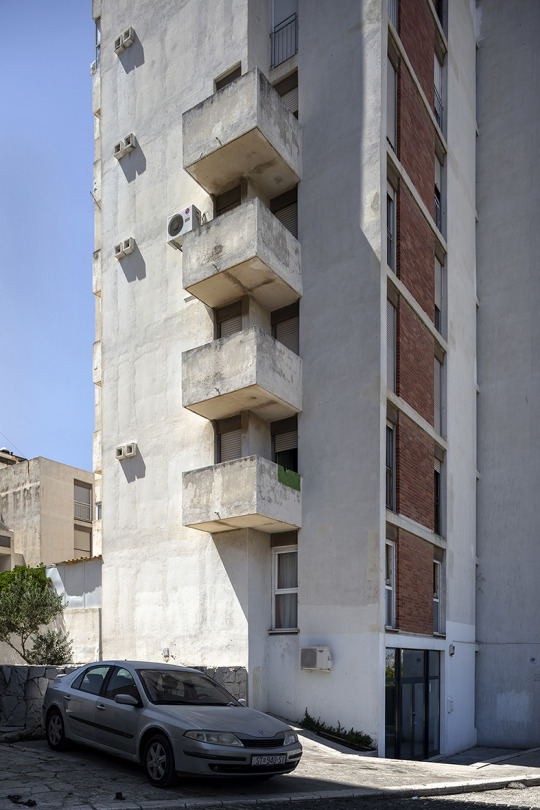
Residential building in Split by Dinko Kovačić | Photo © Roberto Conte
Without the need to gather the material for a specific publication or a pre-determined editorial project I was free to move as much as I wanted so I started to scout the buildings I was more interested to reading some books as Modernism In-Between, checked online databases as Architectuul or the Spomenik Database as well as scouting sites using satellite imagery.

Student Dormitory Goče Delčev by Georgi Konstantinovski in Skopje, Northern Macedonia | Photo © Roberto Conte
We are talking also about the unity in no border’s Europe but during your trip you have to cross many borders?
I travelled for about 9,000 km, crossing each single republic that once formed Yugoslavia, but whose current divisions were pretty much shown by the 15-border crossing I had to queue, and in some cases I had some not kind inspections and questions. Of course I realized the clear differences from some place to another, but at the same time my trip was organized following a common line and I often checked architectures made by the same people but now located in different nations, in many cases neglected, when not even destroyed, like for example the monument in Knin.
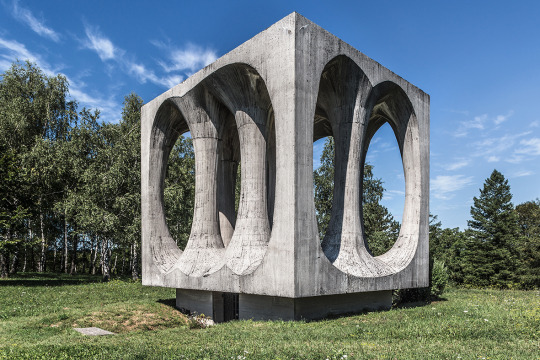
The monument to the National People's Struggle (1964-65) by Janez Lenassi and Siva Baraga in Ilirska Bistrica. | Photo © Roberto Conte
To be honest it was a very weird feeling, as an Italian born in 1980 I remember very well the borders inside the European Union and I am glad to be able to travel from one country to another, on the opposite, a country that was united as Yugoslavia is now so much divided, not only by state borders but sometimes also by ethnic differences inside the same republics.
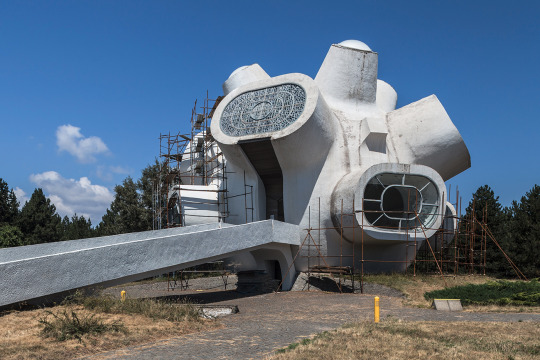
Makedonium, also known as the Monument to the Ilinden Uprising (1973-74) designed by Jordan and Iskra Grabuloska. | Photo © Roberto Conte
But in one leg of my trip, between the incredible memorial complex of Kadinjaća in Serbia and the Bratunac spomenik in Bosnia and Herzegovina, I crossed a border on the river Drina. It was a bit strange to see two fishermen right in the middle of the river, right in the very same waters and immersed in the very same landscape, but ideally located in two different countries.
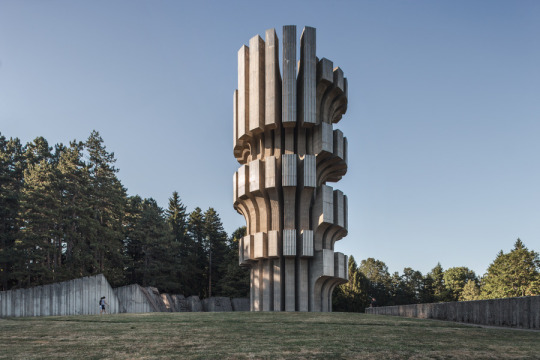
Monument to the Revolution (1969-72) by Dušan Džamonja, at the Kozara mountain, Bosnia and Herzegovina. | Photo © Roberto Conte
Did you have some other encounters?
Beside some recent and pretty ridiculous revival in Italy we have quite a detached relation with our flag, mainly used only for soccer events, and the need of highlighting our ethnical identity. That's also why I found it rather interesting what happened to me between Montenegro and Kosovo. I was at the gas station in Rožaje, Montenegro, waiting for my tank to be filled. Then I heard the horns of a column of cars celebrating a wedding (as we also do quite often in Italy), but the thing is that on the first car there was a huge Serbian flag waving proudly.
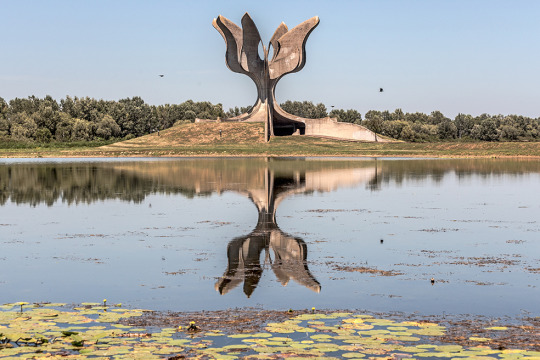
The Jasenovac Monument by Bogdan Bogdanović is devoted to the victims of the Ustasha genocide during World War II. | Photo © Roberto Conte
I found it interesting that a micro-social event, such as a wedding, was considered a good opportunity to wave a flag, moreover considering that these people living in Montenegro was considering themselves more connected to another country, in this case Serbia. Then I crossed the mountain and the border with Kosovo and when I was approaching to the city of Peje I've seen another horning car parade, another wedding, with another flag! And, once again, the flag was about the one of another, Albania. I found these episode quite revealing of a probably diffused attitude.
---
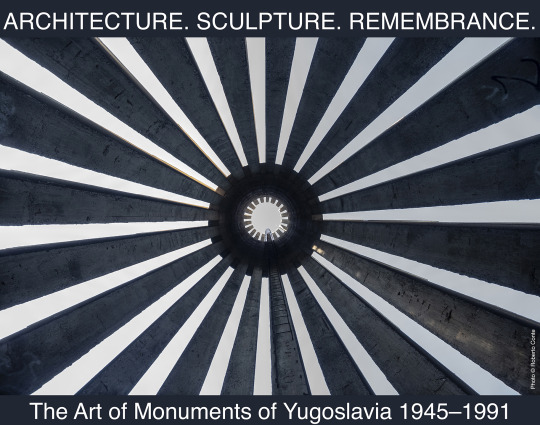
Architecture. Sculpture. Remembrance. The Art of Monuments of Yugoslavia 1945–1991.
Curators: Boštjan Bugarič, Kristina Dešman, Maja Ivanič, Špela Kuhar, Eva Mavsar, Špela Nardoni Kovač, Damjana Zaviršek Hudnik Producer: DESSA gallery Židovska steza 4, Ljubljana, Slovenija Organiser: DESSA gallery, ab_Arhitektov bilten, DAL, Architectuul Mediapartner: Architectuul
*** Also read interviews in DOMUS, ÉPÍTÉSZFORUM and WEARCH
23 notes
·
View notes
Text
CETINJE, THE KEEPER OF 3 GREAT CHRISTIAN WORLD RELICS
The former capital of Montenegro, Cetinje, today preserves the 3 great Christian relics, and as such is the most important Montenegrin cultural, historical and spiritual center.
A beautiful mountainous town at the foot of the Lovcen mountain, which abounds in charm, attracts thousands of tourists because what Cetinje has to offer is rarely seen or felt. The spirit of old times, the energy of the old world is to date still completely preserved and lived here.
When you step into Cetinje, the history well-preserved in the Cetinje Monastery, the National Museum, and The Blue Palace, the Palace of King Nikola will literally enfold before your eyes…
And perhaps the most valuable is what Cetinje keeps in its heart ae the 3 great Christian relics. Just looking at them leaves one breathless.
The Three Great Christian Relics of immeasurable value
Since 1941 Montenegro has been the custodian of important religious relics:
The Icon of the Our Lady of Philermos – the oldest preserved icon in the world of Virgin Mary
The hand of St John The Baptist – who baptized Jesus Christ
Particles of the Holy Cross – part of the cross on which Jesus Christ was crucified
The relics are set in gold frames coated with brilliants, diamonds, rubies and sapphires. It was always known that these have outstanding value, however their first assessment of value was in Russia in 1859 when they were estimated at 24,930 rubles in gold.
Even though the relics have their material side, for the believers they are priceless. These are miraculous relics that give spiritual strength and sublimity, and these cannot be measured in wealth.
FROM ANTIOCH TO CETINJE
How these relics arrived to Montenegro is a truly interesting account. They have been preserved and transferred from country to country for centuries, finally reaching Cetinje where they have been for 8 decades.
After 9 centuries, the relics were transferred from Antioch to Jerusalem, and via Constantinople (todays Istanbul) came to the possession of the Knights of the Holy Crusades of St John the Baptist. They kept then on the island of Rhodes until the middle of the 16th Century when the Turks conquered the Rhodes. The knights then move to Malta, together with the relics, and change their name to the Knights of Malta or Knights of St John, commonly the Knights Hospitaller. The wars continued, and after the conquest of Malta by Napoleon, the knights move to Rome and in 1799 the relics ae handed over to Russian Tsar Paul Petrovich Romanov, Emperor Paul I of Russia. The Romanovs kept the relics until the Russian Revolution of 1918 when Maria Feodorovna (Dagmar of Denmark), the mother of the last Russian Tsar, Emperor Nicholas II of Russia, then transferred them from Russia to Copenhagen.
At the end of her life, she gave them to the Russian Metropolitan Antony Khrapovitsky who brought the relics through Berlin to Belgrade. In Belgrade he gave them to King Aleksandar Karadjordjevic as a sign of gratitude of the Russian people and the Russian church for receiving a large number of refugees from Russia.
The relics were in the Royal Palace in Belgrade until 1941 when King Peter II gave them to the Ostrog Monastery for safekeeping. The relics remained hidden in Ostrog until 1952. After the war, the relics were with the State Security Service which only in 1978 conveys them to the Religious Commission of the then Government of Montenegro. The hand of Saint John The Baptist and particles of the Holy Cross were handed over to the Cetinje Monastery for their final resting place, and the icon of Our Lady of Philermos to the National Museum in Cetinje, where they are still located to this day.
Cetinje, with all the cultural and historical values it bestows on all visitors, is a place that is unavoidable to experience. The confluence of strength, spirituality, life and struggle is carved here in every stone, and visible at every step. The relics are only a part of the enormous prosperity of Cetinje – so let the roads take you to Cetinje next time you visit Montenegro.

#cetinje#saint john the baptist#our lady of philermos#visit montenegro#Montenegro#ostrog#lovcen#blue palace#holy cross#antony khrapovitsky#knights of st john#knights of malta#christian relics
4 notes
·
View notes
Text
Live like a Rockefeller — The Rivals by Diego Rivera
At first glance, Abby Aldrich Rockefeller and the Mexican artist Diego Rivera couldn’t have been more different. She was the daughter of a prominent Republican senator and had married into one of America’s most famous capitalist families; he was a devoted member of Mexico’s Communist party, who had visited Moscow before his first U.S. mural commission in San Francisco.
Abby, however, was a huge admirer of Rivera’s art. He’d developed a reputation as one of his generation’s leading modern artists, and she knew all about his triumphs as a muralist in his homeland (in buildings such as the Ministry of Education in Mexico City), not to mention his mural for the Pacific Stock Exchange Tower in San Francisco. She purchased a number of Rivera’s oil paintings, sketches and watercolours. Her first purchase in 1929 was May Day Parade, a Rivera sketchbook (now in the collection at MoMA), which he had completed on a trip to Moscow.
In 1931, in her capacity as co-founder and trustee of the Museum of Modern Art (MoMA), Abby invited Rivera for a solo exhibition at the institution, making him only the second artist, after Matisse, to receive that honour. It is likely that Mexico had been on her mind for decades, ever since her first trip to the country in 1903. Rivera embodied everything that Abby and Alfred Barr, MoMA’s first Director, were looking for in terms of the museum’s programming: he was both a modernist genius with a towering body of work and as Mexico’s leading muralist, he was the foremost proponent of a genuine art movement from the Americas to the world.
On arrival in New York, Rivera paid a visit to the Rockefellers’ Manhattan home with his wife, the artist Frida Kahlo. ‘He was a very imposing and charismatic figure: tall and weighing three hundred pounds,’ Abby’s son, David Rockefeller, recalled in later life.
Rivera brought with him a new canvas, titled The Rivals, which Abby had commissioned and which he had painted in a makeshift studio aboard the steamship, the SS Morro Castle, en route from Mexico. The painting depicts a traditional festival from the southern Mexican state of Oaxaca known as Las Velas, a colourful celebration in observance of local patron saints and of the natural bounties of spring.
‘It’s undoubtedly one of Rivera’s masterpieces,’ says Virgilio Garza, Head of Latin American Paintings at Christie’s. ‘Compared with his murals — which are epic in scale and content, with sweeping vistas and narratives that are often ideologically or historically driven — this easel painting is equally monumental in presence, yet devoid of Rivera’s politics. It’s a much more intimate scene focused on regional traditions, and the brushwork is deliberately looser.’
Others have praised the rich combination of bright colours, reminiscent of Matisse (whom Rivera knew from the decade he’d spent in Paris, between 1911 and 1921) but also, more pertinently, reflecting the vivid hues evident across Mexico: from its flora to its architecture. ‘And then there’s his modern conception of space through the use of multiple planes of colour that recall the formal effects of synthetic Cubism,’ says Garza. ‘Forms and figures are synthesised and reduced to their essential elements. The viewer’s gaze recedes in stages, from the men in the foreground, to the brightly dressed women under the hanging papel picado. Rivera’s brilliant composition of intersecting planes creates a cinematic narrative.’
The Rivals was as popular with Abby as Rivera’s sell-out MoMA retrospective proved to be with New York’s public. In 1932, she approached the artist about another project: completing a mural for the lobby of the RCA Building, the centrepiece of the Rockefeller Center, her husband, John D. Rockefeller, Jr.’s new complex in Midtown Manhattan.
Rivera’s idea was a fresco on the twin themes of human cooperation and scientific development, and he sent Abby a planned sketch of it along with a letter saying, ‘I assure you that… I shall try to do for the Rockefeller Center — and especially for you, Madame — the best of all the work I have done up to this time.’
In the process of painting the mural Man at the Crossroads, Rivera made several changes to his original sketch that would have fateful consequences. Chief among these was the addition of Lenin’s features into the face of a labourer. When news of this change in the mural reached Nelson Rockefeller, David’s older brother, he asked Rivera to substitute the late Soviet leader for another figure.
The painter, despite many attempts to persuade him, refused. Equally vexing to the Rockefeller family was the depiction of John D. Rockefeller, Jr. on the left side of the mural drinking among a group of men and cavorting with women of questionable repute. The latter was a striking image given the family’s devout religious views and their abstinence from drinking and smoking, as well as the Rockefellers’ firm support of U.S. Prohibition-era laws. With no compromise reached, Rivera was dismissed, and although he was paid in full the mural was destroyed. ‘The mural was quite brilliantly executed,’ wrote David Rockefeller in Memoirs in 2002, ‘but not appropriate’.
Rivera would go on to recreate Man at the Crossroads, in modified form as Man, Controller of the Universe, on the walls of the Palacio de Bellas Artes in Mexico City. Here again, Rivera depicted John D. Rockefeller, Jr. clutching a martini amid scenes of gambling and excess, while the other side featured workers and various Communist leaders.
Despite all these events, Abby and her sons Nelson and David remained admirers until the end. She would donate many of the Rivera works she owned to MoMA, although The Rivals was one piece she held on to. As a sign of how highly she valued it, Abby gave it to David and his wife Peggy McGrath as a wedding present in 1940. They, in turn, would give the painting pride of place, for decades, in the living room of their summer residence, Ringing Point, in Maine.
David Rockefeller’s interest in Latin America and its art and culture spanned many decades. In January 1946, after completing his military service in the Second World War and before he started work at Chase Bank, he and Peggy decided to take ‘a second honeymoon’. They settled on Mexico as the destination for their six-week holiday.
‘This was our first direct exposure to Latin America, and we were very much taken with what we saw,’ David wrote years later. ‘We were especially fascinated by the remarkable pre-Columbian monuments and artefacts, as well as by the charm of much contemporary Mexican painting and folk art.’ He recounted how keen they were to see the famous Mexican frescoes of Rivera, José Clemente Orozco, and Rufino Tamayo in Mexico City and Cuernavaca. ‘We especially wanted to see Rivera’s murals, since I had met Rivera with my mother when he first came to New York in 1931,’ he recalled. ‘I had always found him to be a very sympathetic person, and I liked his painting.’
The couple had travelled to Mexico armed with letters of introduction from Nelson Rockefeller, who had been appointed Coordinator of Inter-American Affairs by President Roosevelt and had subsequently visited virtually all the Latin American nations. One letter was addressed to Roberto Montenegro, an artist friend of Nelson’s, who introduced David and Peggy to other contemporary Mexican artists.
At the beginning of his long career with Chase, one of David’s first assignments was in the bank’s Latin American division. In 1965 he assumed the chairmanship of both the Council of the Americas and its new cultural adjunct, the Center for Inter-American Relations (CIAR). The latter was responsible for introducing Americans to the cultures and artists of Latin America, including staging the first one-man show in New York for Fernando Botero.
In 1991, he endowed the David Rockefeller Center for Latin American Studies at Harvard, which continues to explore Latin American politics, society, and culture, and after his retirement from the bank David was made chairman of The Americas Society, which afforded him, he said, ‘many new opportunities to visit the nations of Latin America and the Caribbean, and to appreciate their diverse art and culture.’
~ ROCKEFELLER COLLECTION | AUCTION PREVIEW · 9 May 2018.
2 notes
·
View notes